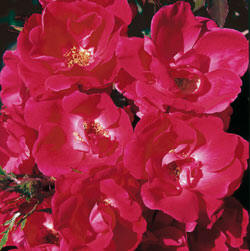Beautiful Roses -
The
Fragrant Star of the Garden
Roses are wonderful plants. They come in all shapes and sizes, hundreds of colors, and many different fragrances and flower forms. Many bloom all summer. There is a rose for almost every purpose in the garden. Roses might be a challenge to grow, but gardeners, especially rose people love the challenge. That’s why growing roses in Colorado is so satisfying.
Our climate ranges from a moderate Zone 4 or 5 in Denver to a cold Zone 2 in the mountains. Temperatures can go from frying to freezing overnight. Most of our native soils consist of either sand or clay. We also have high winds and
mixed-up seasons. On the plus side, we have lots of sunshine and
a lot less trouble with pests than people in more humid, temperate
climates.

There are some great roses like
'Knockout' (pictured) which can bloom like crazy with only 2 hours of sun, is
hardy to minus 20 degrees, It's drought-resistant, disease-resistant, and never
needs deadheading!
By taking special care when choosing a planting site, proper planting, providing winter protection and improving the soil, all of these problems can be overcome. Choose a planting site with a minimum of six hours sunlight a day, protection from strong winds and access to water. (Roses require 1" of deep watering a week.) Planting on the east side of structures or buildings where roses are exposed to the mildest sunlight and protection from the worst of our winter winds, often gives the best results. Avoid planting up against the south or west side of an unshaded structure. Reflected heat can burn your plant in summer, or fool a bush into breaking dormancy in January and February.
No matter your type of soil you have, soil amendments are essential when planting your rose choice. Whether preparing a full bed or just planting just one bush, work in a one third portion of organic material (compost or peat moss), into a two thirds portion of existing soil 8 - 12" deep.
Gardeners are most familiar with modern roses like hybrid tea, grandiflora, floribunda, climbers and ramblers. Not as familiar are some shrub varieties and English roses. Roses that are not hardy in colder climates are usually grafted onto a hardier root stock. They must be protected from severe freezing or they may die back to below the graft and you will only have what come off the root stock below. We can prevent this by covering the graft with 1 - 2 inches of soil when planting and by mulching the canes up to one foot deep in winter.
Mountain gardeners can only grow grafted roses by providing extra winter protection. In the past few years other varieties of roses have been introduced or rediscovered which are growing on their own root stock. Plants growing on their own roots are usually hardier. If they die back to the ground, from the root that grows back is the same rose that you planted.
Some recent introductions that grow on their own roots and are hardy enough to grow in our mountains are Canadian roses. They are similar to floribundas and climbers. Rugosa roses grow 5’-6’ tall and are great for hedges. Mini roses have smaller flowers and only grow 18"-24" tall and wide. A newer introduction is the Flower Carpet rose. It grows 12"-18" tall, spreads 3’-4’ wide and blooms continuously.
Roses that have been rediscovered lately are the Antique roses. These roses have been in cultivation for over 100 years. They are generally larger bushes with strong fragrances. Some are repeating, but most put all their energy into one glorious show in June.